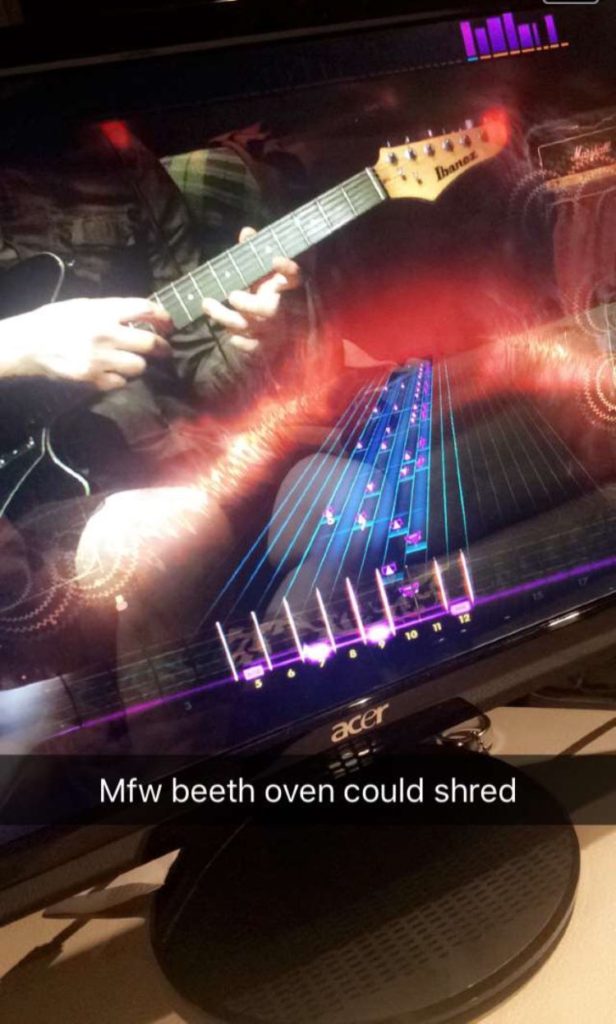Book Impressions: Caretaker, by Josi Russell
Posted by Rampant Coyote on April 25, 2016
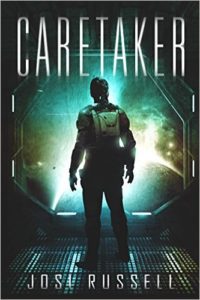 Caretaker, by Josi Russell, is an unusual science fiction book. The story is about Ethan Bryant, a man designated to the sole conscious person – the “caretaker” on a very lonely 50+ year colony ship. He was the last of the passengers to be put into hibernation stasis, but before that could happen, the actual caretaker – the human in charge of maintaining the ship in case of problems during the voyage – died quite suddenly and unexpectedly. The computer then designated him the replacement, even though he has no idea what he is doing. So with his pregnant wife already in stasis, he’s forced to live his entire life patrolling the corridors of a ship, making sure the other 3999 passengers make it to their destination in safety, at which time he’ll be a very old man.
Caretaker, by Josi Russell, is an unusual science fiction book. The story is about Ethan Bryant, a man designated to the sole conscious person – the “caretaker” on a very lonely 50+ year colony ship. He was the last of the passengers to be put into hibernation stasis, but before that could happen, the actual caretaker – the human in charge of maintaining the ship in case of problems during the voyage – died quite suddenly and unexpectedly. The computer then designated him the replacement, even though he has no idea what he is doing. So with his pregnant wife already in stasis, he’s forced to live his entire life patrolling the corridors of a ship, making sure the other 3999 passengers make it to their destination in safety, at which time he’ll be a very old man.
Then one day, five years into his lonely vigil, one of the stasis pods activates, and Kaia emerges – a beautiful engineer who had been secretly married to the original caretaker.
The first half of the book is fairly slow paced development of the two characters and an emerging mystery on the ship. Ethan is a specialist in a “useless” field – an expert in a long-dead alien language. Kaia is a brilliant engineer who had designed parts of the class of colony ships like the one in which they are traveling. It’s clear that Ethan desperately needs the companionship, but as their relationship continues it threatens his intention to remain faithful to his wife.
And then there are some anomalous readings on the ship, and things that don’t make sense… especially when they conflict with Kaia’s understanding of how things should be laid out. And was the original caretaker’s sudden death natural, or was it murder? And what is Kaia actually up to?
As they have a 50 year voyage ahead of them, they don’t feel particularly pressured to solve everything all at once, which further slows down the pace of the first half of the book. It feels leisurely, and while very interesting and character-building, it’s not really action-driven or plot-driven. And there are times where the science is kinda questionable. I guess Star Wars and Star Trek got it a lot worse, but still…
Anyway, the mystery heats up, but as soon as our two heroes figure out what’s really going on… well, all hell breaks loose. And suddenly our slower-paced sci-fi drama / mystery turns into a hell-bent-for-leather full-on epic pulp SF. I don’t want to spoil anything any more than I have (although that much is strongly suggested on the back cover). This was good ol’ action-adventure SF that left me wondering how they were possibly going to get out of the current fix. It’s good ol’ fashioned planetary romance and a lot of fun, with the addition of more detailed characters developed in the earlier stage of the story.
Now… the only big issue here is that the change of pace is so jarring that it’s almost like two different books. Same characters, same story, but even with the ramp-up in the mystery in the first half, it’s still a little jarring. That may be a major irritant for some readers, as may the bit of hand-waviness on the science side. But while a little bit rough in those respects, I thought it was a good freshman novel from Russell, and I’m looking forward to reading the sequel, Guardians, released earlier this year.
Filed Under: Books, Impressions - Comments: Comments are off for this article
Games as Art: Communication Required?
Posted by Rampant Coyote on April 22, 2016
 I recently read an old essay (we’re talking pre-WWW!) discussing what makes art, and the author suggested that for a work to be art it has to engage the audience in a conversation… inviting them to mentally and / or emotionally contribute, interpret, and invest something of themselves into the work to derive meaning from it. This was a powerful thought that left me thinking about it for a while afterwards. Which, I guess, might nominate the essay as art? (Note to self: inviting audience contribution might be necessary, but probably not sufficient, criteria).
I recently read an old essay (we’re talking pre-WWW!) discussing what makes art, and the author suggested that for a work to be art it has to engage the audience in a conversation… inviting them to mentally and / or emotionally contribute, interpret, and invest something of themselves into the work to derive meaning from it. This was a powerful thought that left me thinking about it for a while afterwards. Which, I guess, might nominate the essay as art? (Note to self: inviting audience contribution might be necessary, but probably not sufficient, criteria).
I’ve always valued the media that encouraged me to invest a bit of myself into it, but I never thought of it being the difference being that which separates ‘art’ from ‘non-art.’ This definition would probably preclude any work in any medium that is too literal, too “preachy” (leaving little or no room for audience participation & interpretation), or … on the flip side … too abstract or minimalist, which “contributes little to the discussion.” Note that the audience simply refusing to invest of themselves and contribute (because they don’t like the subject matter, or what have you) doesn’t impact the artistic quality of the work. It just means that beauty is in the eye of the beholder.
This has a lot of ramifications. It also suggests a spectrum rather than a dividing line. Photography requires a great deal of the photographer to push it up the capital-A Art side of the spectrum… but really, that’s true of all media. Your average crowd-pleasing summer blockbuster would probably come out on the low end, which is sadly appropriate even to this fan of big summer blockbuster films. It would also mean a lot of the horrible preachy books that some folks like to elevate with awards would also not score very high on this particular Art-meter, which tickles me a bit. It tends to naturally elevate science fiction (and speculative fiction in general, to a lesser degree) because of the ease in which that kind of fiction raises questions about the human condition and the future of our species and role in the universe, without having to provide the answers.
It’s not a forgiving criterion for most video games, however. Video games, particularly those that address the mass market (similar to the Hollywood blockbuster films), tend to be pretty literal. What you see is often what you get. While the audience is certainly welcome to inject their own ideas about the world of Super Mario Brothers, what’s on the screen is pretty straightforward. For me, I don’t see much of an invitation to contribute.
More exploratory games, however, probably get bonus points, simply because the invitation to explore may also be an invitation to engage the imagination. Sometimes.
 For video games as a whole, I don’t think the literalness (that really is a word; I looked it up!) is a requirement for video games, or necessarily a restriction on their potential. I think a lot of games have done that. I think a lot of games have tried, and failed. It takes a lot more than just throwing in a controversial or politically charged element. I think some games that might rate higher on this measure of the artistic scale have done so almost by accident. Some great examples (for me) of games that I’d rate higher (given my own subjectivity of what really invites my participation) would be: Braid, The Sims, Shadow of the Colossus, Emily Short’s Galatea (or pretty much anything by Emily Short), and Jason Rohrer’s Passage. Ultima 4 and 5 would, for me, be moved along to a comfortable spot on the artistic spectrum. While I can’t say it inspired truly “deep thoughts” from me, Minecraft would score pretty well here, and I know it has inspired amazing creativity from tons of players. Spec Ops: The Line at least attempted this as well, and I’ll give them points for effort even if execution was (for me) a bit lacking.
For video games as a whole, I don’t think the literalness (that really is a word; I looked it up!) is a requirement for video games, or necessarily a restriction on their potential. I think a lot of games have done that. I think a lot of games have tried, and failed. It takes a lot more than just throwing in a controversial or politically charged element. I think some games that might rate higher on this measure of the artistic scale have done so almost by accident. Some great examples (for me) of games that I’d rate higher (given my own subjectivity of what really invites my participation) would be: Braid, The Sims, Shadow of the Colossus, Emily Short’s Galatea (or pretty much anything by Emily Short), and Jason Rohrer’s Passage. Ultima 4 and 5 would, for me, be moved along to a comfortable spot on the artistic spectrum. While I can’t say it inspired truly “deep thoughts” from me, Minecraft would score pretty well here, and I know it has inspired amazing creativity from tons of players. Spec Ops: The Line at least attempted this as well, and I’ll give them points for effort even if execution was (for me) a bit lacking.
A few RPGs could probably fit this description, but I think some of the more modern ones try too hard to appear relevant without allowing the player a (figurative) word in edgewise. Games with multiple endings based on player choice is a great idea in theory (and not limited to RPGs), but too often it’s one-good-ending plus two or three variations of suck. If this was a conversation, this is the equivalent of yelling “BZZZT! WRONG ANSWER!” and pretentiously dropping the mic.
While I don’t necessarily care about “games as art,” I do like the idea of more games serving up more intellectually and emotionally stimulating content that challenge and inspire players. Heavy-handed “message” games or games that depend on shock value need not apply … not that they are necessarily bad, only that these techniques don’t inspire much contribution from a player. But with subtlety (yes, not something that usually works well in video games), the interactivity of games could really act as a mirror to the player’s own values and engage in a “conversation” far better than any static medium.
Stuff to consider.
Filed Under: Art, Geek Life - Comments: 4 Comments to Read
Extreme Guitar…
Posted by Rampant Coyote on April 20, 2016
I’ve been waiting for this song to his Rocksmith since launch. If you need me anytime in the next three months, I’ll be learning to play it… holed away in some monastery of rock up in the mountains…
Rocksmith may be pretty good, but it can’t work miracles, especially when my average lately has probably only been about 20 minutes a day. But hey, aspirations and lofty goals. One day I’ll be awesome at guitar, have a couple of best-selling book series out, and make the indie game that outsells Minecraft. Then I’ll have to figure out what to do next.
Filed Under: Guitar Games - Comments: Comments are off for this article
Game Dev Employees vs. Hobbyists vs. Entrepreneurs vs. Old-Schoolers vs. Everybody Else
Posted by Rampant Coyote on April 19, 2016
A few days ago, Alex St. John enraged the game development community with an extremely tone-deaf post about game development working conditions. A gazillion articles have been written lambasting this article, so I’ll actually sidestep that pile-on just a smidgen. I’m not going to defend him, because he’s wrong, but I would suggest there’s a middle ground we’ve got to reach.
I have a friend who worked at an independent game studio and was in charge of developing the expansion (back in the day when they were called expansions and not DLC) for a major hit game. The project manager from the publisher/studio that had made the original game was pretty much camping at the door of the office, and was super-excited, super-committed, and everything. Well, my friend wanted to go home and see his family once in a while. So he was “only” working 60-hour weeks on this expansion.
At one point, the project manager asked my friend the lead programmer why he wasn’t more committed and putting in more hours. After all, this expansion was going to make a fortune!
“Not for me,” my friend said. I don’t remember if he was expecting any kind of minor bonus for hitting his milestones, but otherwise he was only getting paid his standard salary.
The project manager was baffled. He started to say how much they were paying the independent studio to develop the expansion, but stopped himself. He hinted that it was a LOT of money, however. Plus a piece of the royalty action. Enough to really motivate a team to pull out all the stops and make an incredible expansion to a best-selling title. But it wasn’t going to the team… at least not directly. It was going to the company coffers to help keep the medium-sized studio afloat during all the upcoming times that might not be quite as lucrative.
Reasonable? Sure. But not personally motivating. Why would I want to nuke my health and jeopardize my family and work my butt off just so my bosses could get really good bonuses, my co-workers who aren’t directly working on my project could keep getting paid, and that I might see an extra four months of employment at some future point rather than taking another job elsewhere?
This is the challenge and contradiction of the video games biz. The industry has matured wonderfully in some areas from its crazy, heady early days, yet is woefully immature in others. While the big hits generate amazing revenue, everything else does poorly. We’re talking not even breaking even, considering the cost of development. Do a REALLY good job, and maybe you don’t get laid off.
The guys who have survived the industry for a long time remember the crazy early days. Then, a handful of people with an idea, passion, and an apartment they could use as an office could live on Top Ramen for a few months and crank out a commercially viable game that would at least generate enough royalty payments that they could graduate to real ramen and occasionally pizza when developing the next game. And if they had a genuine hit, the back-end royalties would make everyone on the team rich. Maybe not fly-yellow-Ferrari-and-a-penthouse-rich, but maybe pay-off-the-mortgage rich. But of course, these guys are the survivors. There were a lot who didn’t. They never upgraded from Top Ramen, and had to eventually call it quits. They aren’t in the industry or guiding things anymore.
Things are even rougher now. The industry is far more crowded than it used to be. Supply has grown much faster than demand, especially during the indie revolution. This is part of the whole “industry maturing” thing. For the biggest games, the team size is huge, and one person’s creative contribution is relatively minor. Their stake in the project is also relatively small. It’s work. It’s like any other profession.
And that’s exactly how it’s supposed to work, after a point.
You can be an employee. You can trade your chance at a big gain for relative stability and a steady paycheck and 9-to-5 hours. And that’s fine. That’s awesome, actually. And you can still be awesome and passionate about it, do excellent work (you should!), and be very proud of what you’ve accomplished. Put it on your resume. Just don’t complain when, as a result of your steady and stable work that you’ve put in, your employer or the other stakeholders get rich, and you get nothing special. That’s your choice. And as an employer, that’s great too – you get a huge gain for relatively low, steady costs. Win-win all the way around, at least when starting out and the future is hazy.
You can be an entrepreneur. You can take the big risks, work the crazy hours, for very little more than a gamble… a stake in the prize if your team can defy the odds and be really successful. And that’s awesome, too. Especially if the whole team is that way. Everybody shares in the risk, everybody shares in the reward. Either way, it’s fair. And since there’s a higher sense of ownership and real stakes involved, sure, people may tend to work the psycho hours. Win-win for everyone, at least if the project is successful.
You can work as a contracted gun-for-hire. That’s awesome, too. You stay independent. You chart your own course. You do your work, you get paid your cash, and you are only peripherally interested in how the project fares after you are done. Sure, a hit game means a resume point and hopefully continued contracts with that developer, but it’s not about you. It’s great for the employer too, because you represent fixed, one-off costs for them. Win-win!
You can work on a project as a hobbyist. People do it out of pure passion, with little thought of the big bucks on the other side. It’s a resume-builder, a learning experience, a marketing tool, and maybe worth a little bit of cash on the side. Mainly, it’s an investment in the future. Nobody expects to make minimum wage on the thing. Naturally, it takes a lower priority when Life Happens. Everybody expects that. People gotta do other things to pay the bills. They work on this project out of passion (and maybe token payments). This is fine and good and fair, and everything is cool here, too, so long as everyone’s on pretty close to the same page. Win-win all the way around.
All four of these approaches are fair and awesome and will absolutely work today. No problem. In fact, these aren’t the only options – you can work out some kind of balance, maybe sacrificing a some salary for a bigger piece of the reward, or vice versa.
The problem is when someone tries to mix-and-match requirements and expectations to the detriment of someone else. You can’t alternately treat someone as an employee, a contractor, a hobbyist, and an entrepreneur when it benefits YOU. This is exactly the problem that disgusted me with the mainstream games industry. There’s this legacy of entrepreneurship that is AWESOME, but companies want to treat employees like entrepreneurs who don’t actually get to participate in the rewards of entrepreneurship. When someone is asked to shoulder much of the risk without a significant portion of the reward. And that’s exactly what pushing employees to work 80 hour weeks, destroying their health, possibly wrecking their families, for nothing but a token reward at the end is doing.
It goes both ways, though. I hear some very unreasonable demands from employees, too. If you are doing work for someone else, you can’t demand everything … regular hours, high pay, great benefits, AND as big a stake in the company or project as people taking much bigger risk. Sorry, it doesn’t work that way.
Fortunately, it’s a free economy (at least where I live). In theory, at least … regulations really make things more complicated. In spite of screeds about passion and privilege and artistry, I’m absolutely free to tell to go tell someone demanding that I bleed for their benefit to go screw themselves. That’s how it should work. Which is why I’m totally happy about people dumping on Alex St. John right now. This is not a black-and-white issue, and there are tons of variations on what is acceptable and what isn’t, and I don’t think one size fits all, or even many. But there’s a weird attitude in the games industry (and probably similar industries, like music and Hollywood) that should be stamped out now.
Look, you want me to be passionate about develop games? You want me to just create for the joy of creation? To enjoy the privilege of making games? YOU GOT IT! But then I’m not making games for you. I’ve gone indie, I’m working a 9-5 job, and I’m making my own games in my spare time and loving it (most of the time). Or getting together with friends to do something great together! Awesome. All that and maintain a balance in life that allows me to be happy and not just a starving, depressed, overworked artist.
Do you want me to make a game for you and help you make lots of money? Cool, I’m happy to do that too, but you need to offer me something significantly more than just the joy of making games. I’ve already got that one covered.
Filed Under: Biz - Comments: 6 Comments to Read
Thoughts on Vive VR
Posted by Rampant Coyote on April 18, 2016
I had the chance to play with the HTC Vive VR, the product of Valve’s partnering into the wild, wonderful world of virtual reality. While the experience wasn’t quite up there with The Void, it was still a pretty cool experience.
The person giving me the demo was Bryan Livingston of Legend Studio, maker of A Legend of Luca, a room-scale VR action-roguelike game. First, I played around with a few other demos, including the tremendously awesome Portal-world demo where you try and repair one one of the robots. There was also a game where you sliced fruit, fruit-ninja style, as it launched at you. The amazing thing with this one was how natural it all felt with the wand controller. There wasn’t much training your body to do things. Tapping the fruit (or bombs) to move them off to the side, or bouncing something something on the flat of the blade, was a piece of cake.
Google’s Tilt Brush is also kind of amazing.
Playing these kinds of games in VR is a different experience than sitting down and using a controller. It’s a much more active experience, but they didn’t make me motion sick. It was really like I was just entering another world. A world constrained to about fifteen feet by fifteen feet for practical reasons, but it was effective.
A Legend of Luca has a very interesting scheme. In order to make movement and room sizes from traditional games work for the game, the world is scaled down. When the game launches, you set the height of the floor to about your waist. Once you do that, you move around and shoot like a first-person shooter / slasher. The effect feels like you are constantly leaning over (or walking through) a miniatures table in a wargame of some kind. It requires a bit of jumping and dodging.
One of the interesting ideas from this game is that the UI is located above you, so you have to glance up to see the map, etc.
Part of the discussion we had with Bryan was how VR changes the language of video games. So many standards that have evolved when presenting experiences on the screen, with a controller or the keyboard in front of you, are completely turned on their head in virtual reality. When the brain is convinced that it’s “in” a place, it expects the virtual world to conform to many real-world expectations. Anything else, and weird – often bad – things start happening.
I think we’re still in the ‘early adopter’ stages of this technology. It is really amazing, but it’s not a case of where everything belongs in VR. It’s not a place you’d “port” a game. It demands a special kind of game, and I’m excited to see what kinds of experiences evolve over time… and how the technology itself evolves.
Filed Under: Virtual Reality - Comments: Comments are off for this article
Book Impressions: Pwned
Posted by Rampant Coyote on April 15, 2016
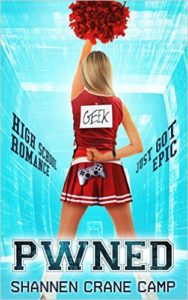 Pwned, by Shannen Crane Camp, is a story about Reagan West, the co-captain of the high school cheerleaders. She’s beautiful. She’s popular. She can be kind of mean. But this is all to conceal her terrible secret… her secret identity:
Pwned, by Shannen Crane Camp, is a story about Reagan West, the co-captain of the high school cheerleaders. She’s beautiful. She’s popular. She can be kind of mean. But this is all to conceal her terrible secret… her secret identity:
Reagan is a gamer. A full-on uber-geek and MMORPG (Massively Multiplayer Online Role-Playing Game) addict. If that secret were to get out… well, she knows her crowd. She knows her best friend and co-captain of the cheerleading squad. She knows that no geek or social outcast has ever suffered as she will if she if her double life is exposed.
So far, she’s been able to keep her two lives separate. But now, her two worlds are about to collide, and she may have to finally pick a side.
So… this is not my usual reading fare (contemporary young adult romance), but obviously the subject matter is a hook for me. The fictional MMO in the story sounds suspiciously like World of Warcraft, but if you’ve put any time into any MMORPG, you’ll find yourself at home. In fact, if you aren’t a gamer, you might have a little trouble with some of the terminology, although the author does a pretty good job of explaining anything that’s not obvious from the context.
I have no idea about the life of a high school cheerleader, but Shannen Crane Camp gets the MMO / gamer side right. I met her at FanX and at a party during LTUE this year, and this is no surprise. She is very much a geek, a hardcore MMORPG fanatic, and a confessed “alt-aholic,” just like her character. Naturally, that side of things comes across as pretty authentic.
Overall, it’s a cute story. Reagan is a very interesting character. Her cheerleader persona can be mean, but she’s never irredeemably bad. The characters are well-drawn and interesting. The cute nerdy guy is smart but appropriately clueless in certain areas. Some of the twists are a little on the predictable side, and the ending felt a bit forced to me. It’s YA, which will be great for some readers, and not-so-great for others. I enjoyed the references to real-world people and events by gaming terms, since I do that all the time. 🙂 Flaws aside, it was a fun story and I enjoyed it.
Filed Under: Books, General - Comments: Comments are off for this article
Why Do We Bother?
Posted by Rampant Coyote on April 13, 2016
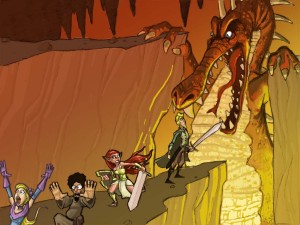 Sometimes, the whole authoring gig & indie game dev thing gets me down. The hours are long. I’m rarely current on any television shows. My list of unplayed games and unread books grows. I get stressed. There’s a crapload of work. We have deadlines to meet which are rarely convenient. I’m not getting rich or famous from doing it. I face plenty of rejection and criticism. I see how far I am from being great at this stuff, and it’s daunting.
Sometimes, the whole authoring gig & indie game dev thing gets me down. The hours are long. I’m rarely current on any television shows. My list of unplayed games and unread books grows. I get stressed. There’s a crapload of work. We have deadlines to meet which are rarely convenient. I’m not getting rich or famous from doing it. I face plenty of rejection and criticism. I see how far I am from being great at this stuff, and it’s daunting.
It can get rough and demoralizing. Why do we bother creating stuff in the first place?
But then, I have the good nights. A manuscript is completed. A level is done. A new game system is completed. I get positive feedback on a beta. I get an acceptance or… a game release. My stuff actually *entertains* someone. I can see myself getting better at what I do. These kinds of experiences are help make everything else feel worthwhile.
There are other things, too. A positive review. An award. A halfway decent check or deposit. These definitely big motivators. But not enough to keep me going if I didn’t love it.
Ultimately, in spite of the times where you just have to knuckle down and get the less sexy stuff done, it really comes down to having the creative desire in your blood. When it just comes down to the fact that you are taking these worlds in your head (or heads, if you are collaborating) and converting them into a form that can be shared with others. And then once you start going down that path, it’s hard to stop.
Ultimately, that’s why I’m still an “indie evangelist.” It’s not that I love the flood of crappy entertainment clogging the pipelines. Or that every indie work is some kind of special snowflakey gem. It’s just that I love living in a world where anybody who has a passion for this kind of thing can make it their gig. They don’t need anyone’s permission but their own.
Filed Under: General, Indie Evangelism - Comments: 2 Comments to Read
Unity Asset Store Community Sale: ProBuilder Advanced On Sale
Posted by Rampant Coyote on April 12, 2016
Unity’s community sale is going on for the next 3 days (as of this post). One of the assets on sale is ProBuilder. I have high recommendations for this one. We’re using it in Frayed Knights 2: The Khan of Wrath (actually, we’re taking advantage of much of the ProCore Bundle Package… which sadly isn’t part of the sale) and it’s been awesome. We started out using it just for prototyping levels, and we’re using it to produce final levels. Mainly because Nick Lives is becoming a god at ProBuilder. A mad, bloodthirsty god, but we can live with that.
Unity Asset Store Community Sale
Filed Under: Game Development, Tech - Comments: Comments are off for this article
League of Utah Writers Spring Conference
Posted by Rampant Coyote on April 11, 2016
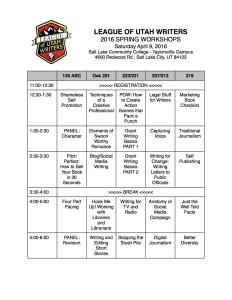 Over the weekend I attended the League of Utah Writers Spring Conference (Workshop) held in Taylorsville, Utah. My friend John Olsen went into more detail (and took way more pictures – my two didn’t turn out well), and has a write-up of his experiences here.
Over the weekend I attended the League of Utah Writers Spring Conference (Workshop) held in Taylorsville, Utah. My friend John Olsen went into more detail (and took way more pictures – my two didn’t turn out well), and has a write-up of his experiences here.
With so many different classes packed into a little under six hours, there were several classes I wanted to attend but couldn’t. But here’s a quick run-down of what I did see!
I started out by hitting Ali Cross’s class on writing action scenes. Her focus was mainly on fight scenes, but she did use a chase scene as an example. The bulk of the seminar was on keeping it real… or at least within the realm of believability. This covered a range of topics.
One suggestion: Don’t make your protagonist suddenly turn into a martial arts legend able to defeat trained special forces agents all of the sudden if that’s not their background. However, they can be given one good trick that they believably picked up from somewhere which allows them to fight back enough to escape. She used Melissa McCarthy’s character in Identity Thief as an example… I never saw the movie, but the character was good at punching people in the throat.
Another point was to keep things grounded, and remember the terrain and the character’s entire body. Even if it’s fighting a dragon. People need room to fight, and remember how much of their body needs to go into a move for it to be effective.
Finally, we discussed writing techniques, and how a lot of it depends on whether it’s a plot-focused action scene or a character-focused action scene. Plot-focused scenes tend to be more blow-by-blow, and character-focused tend to omit more of the details and focus on what’s going on inside the character’s head. Remember point-of-view, avoid passive voice, and try to keep the sentences quick and punchy. Another trick is to keep the verb and direct object as close to together as possible. An action scene that goes longer than a page will fatigue and bore the reader, and that’s a really, really bad thing in any scene, but especially an action scene.
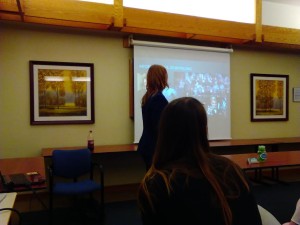 Next I attended editor Callie Stoker’s workshop on voice. She covered both character voice, and authorial voice. She started by having people describing Mr. Darcy, Harry Dresden, and Jay Gatsby’s big party… then read how they were introduced in the books. Interestingly enough (and I’d totally forgotten this), in The Great Gatsby it was almost entirely in the head of the narrator… how it all felt, rather than a physical description. She involved the audience for practice changing words in sentences to give them more of a “voice” – first character, then authorial, then transitioning between the two in the same sentence. It’s a tricky balancing act, and I thought the workshop was extremely useful. I also came to realize how much I suck at this.
Next I attended editor Callie Stoker’s workshop on voice. She covered both character voice, and authorial voice. She started by having people describing Mr. Darcy, Harry Dresden, and Jay Gatsby’s big party… then read how they were introduced in the books. Interestingly enough (and I’d totally forgotten this), in The Great Gatsby it was almost entirely in the head of the narrator… how it all felt, rather than a physical description. She involved the audience for practice changing words in sentences to give them more of a “voice” – first character, then authorial, then transitioning between the two in the same sentence. It’s a tricky balancing act, and I thought the workshop was extremely useful. I also came to realize how much I suck at this.
Lisa Mangum, author and editor for Shadow Mountain Publishing, ran a workshop on creating pitches for books… emphasizing the ability to sell a book in 30 seconds (or less). While that was the hook, the workshop was a bit more comprehensive than that, covering everything from composing tweet-sized pitches to writing a full synopsis for an editor. The idea was to use the smaller pitch to engage enough interest and attention to share the next bigger, more information-packed pitch. Some tidbits (especially when working with editors): Really know what genre and story type you are working with. While we may resent being put into those boxes, it’s a shorthand to communicates a lot of information in very few words. Another point she made is to think about our favorite book, and think about how we tell our friends about it. THAT is how we should talk to other people about our own books. That feeling, if not wording.
Michael Bacera’s session on creating a social media campaign was a LOT more useful and information-dense than I anticipated. John has some good stuff in his write-up on this one, but I seriously couldn’t keep up with the notetaking. His focus was on creating engaging content that invited action, rather that “trying to sell to your followers,” which doesn’t do so well and tends to piss off your audience, and creating a full-on campaign plan with measurable results.
Finally, Paul Genesse – always an entertaining speaker – talked about writing short stories. He spoke on the whys and the hows of writing short stories – with a lot of emphasis on the whys. Of course, the days are long past when an author could make a living writing short stories (not that it was ever super-lucrative). But there are still reasons to make short stories, not the least of which is that it allows authors to experiment, hone their craft, and get some ideas out there really quickly.
I felt the conference was valuable. My wife asked how it compared to LTUE a couple of months ago. LTUE definitely drew in the bigger names with more experience and more established credentials. However, a lot of the presenters at this conference. were the same people on panels at LTUE, but who now had the stage to themselves to get into a lot more details with a smaller crowd, rather than it being a survey of advice. There were panels as well, but I didn’t attend any. I think given my current experience level (still sucking but sucking a lot less than when I started), I am definitely in the position to learn a lot from both.
And now I totally want to see a similar, local conference focused on game development!
Filed Under: Books, Events - Comments: Comments are off for this article
What Am I Playing / Reading? That’s a Complicated Question!
Posted by Rampant Coyote on April 8, 2016
When people ask me what video game I’m playing or book I am reading, I tend to stammer a lot. I mean, if they are pointing to the screen or the book in my hand, then sure. No problem. But if someone asks it as a more generalized question, like “What have you been reading / playing lately?”, then… it gets weird.
I worry that I have some kind of ADD thing going on with my entertainment media. But I guess an analogy might be a television show. At least, back in the days of network TV when we didn’t binge-watch. And when I used to, like, watch television regularly. It’s that thing people who aren’t gamers / game developers / writers do. I have to think waaay back.
But back then, it was expected that people were watching shows, plural. What shows are you watching? What shows do you watch?
I have well over 100 role-playing games installed on my desktop. ONE HUNDRED. And that’s just role-playing games. How many of them have I played? How many do I expect to continue playing? (Hint: If I haven’t uninstalled them, that means something). How many do I consider “actively playing?”
Maybe I have a focus problem.
Books – same deal. Mostly. I’m reading a lot of anthologies and magazines of short stories right now, so it’s a little haphazard. There’s no need to read them in any order. Short stories work really well with my schedule. But then I’ve got books. I’m usually in the middle of reading two nonfiction books, at least one paper novel, and at least one digital novel. That often comes down to “what do I have at hand when I find myself with time to read.” I often have my tablet with me when I find I’m stuck waiting somewhere, so I have time to get a couple chapters of reading done with an ebook.
At least my currently reading / currently playing list isn’t as big as my to-be-read/to-play list.
Filed Under: Books, Geek Life - Comments: Comments are off for this article
Rogue One: A Star Wars Story? Yeah, I’m excited.
Posted by Rampant Coyote on April 7, 2016
“It is a period of civil war. Rebel spaceships, striking from a hidden base, have won their first victory against the evil Galactic Empire. During the battle, Rebel spies managed to steal secret plans to the Empire’s ultimate weapon, the DEATH STAR, an armored space station with enough power to destroy an entire planet.”
That’s the first two-thirds of the opening crawl to the original Star Wars, later subtitled “Episode 4: A New Hope.” When I was a kid, the implication… in the style of the old Flash Gordon serials that Lucas emulated for Star Wars… was that this was a summary of what happened in the imaginary Episode 3.
When Lucas finally got around to making the prequel trilogy, he trashed that idea.
But now… FINALLY… my inner eight-year-old might get to see something worthy of his imagination. Because they are making that story. It’s called Rogue One, and it’s the first of the one-off Star Wars films that will be coming out between the episodic films. These will take place at different times and places in the Star Wars continuity.
The trailer dropped this morning, and I’m excited. This one has a younger Mon Mothma, and a rag-tag bunch of rebel agents kicking butt against good ol’ fashioned original-trilogy enemies (Storm Troopers! AT-ATs!) plus a whole lot more. Since this is the first Death Star, I guess many Bothans won’t have to die just yet. Also, since the only two Jedis left in the universe are still in hiding, we’re probably not going to see much of the Force in this one. Which I am more than okay with.
Star Wars Episode VII: The Force Awakens gave me faith in the franchise again. Yeah, flaws and all. After watching it three times, I think I prefer it over Return of the Jedi. I’ve got confidence that Disney can do a good job with the franchise, and I’m giving myself permission to be as excited as hell over this movie.
Filed Under: Movies - Comments: Comments are off for this article
Dragoncon Awards
Posted by Rampant Coyote on April 6, 2016
 There’s a new awards thingy happening, and you can get involved!
There’s a new awards thingy happening, and you can get involved!
DragonCon is launching a new set of awards, the bulk of which are going to novels of many different speculative fiction categories. Sadly, there are no categories for shorter works of fiction (or poetry), HOWEVER… there are several categories going to GAMES!
And it’s free to join. No big membership fee.
The nomination process is going now, and will be closed at the end of July. Then there’s the voting period. The awards will be held on Labor Day Weekend at DragonCon in Atlanta.
You can participate by going here and checking out the links.
Filed Under: Events - Comments: Read the First Comment
Create Something New
Posted by Rampant Coyote on April 5, 2016
Dave Farland, fantasy author, writes about “Dream Making.” This hit home:
“But several times in the past few weeks, I’ve heard people describe the basic ideas for their novels, and felt that the basic concept was so weak, that I had to wonder, “Why would you write that one?” In each case, I was talking to speculative fiction writers and the idea for the novel was so simple that I had seen one like it perhaps a dozen times before. Maybe I’ve seen too many ideas, but I can’t help but think that the novelists in these cases somehow . . . went astray.”
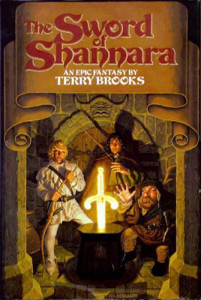 It sounds to me that he’s hearing a lot of pitches that are overwhelmingly “been there, done that.”
It sounds to me that he’s hearing a lot of pitches that are overwhelmingly “been there, done that.”
Welcome to the indie game nightmare. This is nothing new to either field. Gaming had innumerable clones of Pong and Space Invaders in the early and late 70s, respectively, while the heavily Lord of the Rings inspired fantasy hit Sword of Shannara came out in 1977. But it was hardly the first of the “me, too” inspired fantasies.
It makes sense on one level. Face it… most of us do this stuff because somewhere along the line we were inspired. And like they say, imitation is the sincerest form of flattery. We want to recreate what we love.
In an empty, hungry market, there’s room for that. That worked for Terry Brooks, who took the best-selling Shannara series in many new directions over the years.
That’s why game publishers (and developers) get so excited about new platforms. They create a new, empty, hungry market.
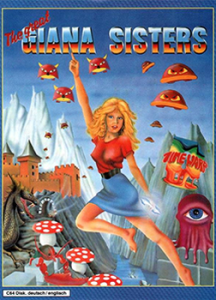 In a saturated marketplace, it’s a whole ‘nother story. Sure, you can make your own special version of Super Mario Brothers. For you, it may be a fantastic exercise. But in a world that already has that game, and sequels, and clones, why would anybody else need to play this game?
In a saturated marketplace, it’s a whole ‘nother story. Sure, you can make your own special version of Super Mario Brothers. For you, it may be a fantastic exercise. But in a world that already has that game, and sequels, and clones, why would anybody else need to play this game?
And that’s really the cool area to focus. This shouldn’t dissuade you, it should excite you. Because that’s what we’re all about… creating new worlds, new experiences.
One piece of advice I’ve frequently heard is to write your marketing copy first. Use that as an opportunity to get to the core of what your game or story is about, and also single out the key elements that makes it cool, unique, and interesting. Once you have that fleshed out – and it’s not big, we’re talking two, three, maybe four paragraphs – and you read it and it makes you desperately wish someone else had already made it so you could play it / read it NOW – then you are ready to begin work on it.
The audience wants something familiar but new. Don’t skimp on the new. Be creative!
Filed Under: Design, Writing - Comments: 3 Comments to Read
Guitar Hero Live is Dying…
Posted by Rampant Coyote on April 4, 2016
 My sympathies go out to the people laid off from Freestyle Games, makers of Guitar Hero Live. This pretty much nails the coffin shut on the Guitar Hero franchise. Things don’t sound great for Rock Band 4, either. It seems like the planned resurgence of the music rhythm game genre ain’t happening.
My sympathies go out to the people laid off from Freestyle Games, makers of Guitar Hero Live. This pretty much nails the coffin shut on the Guitar Hero franchise. Things don’t sound great for Rock Band 4, either. It seems like the planned resurgence of the music rhythm game genre ain’t happening.
This kinda bums me out, but by the same token, I think I have some DLC for Rock Band 3 on my XBox 360 that has never been played. And I don’t have a next-gen console yet. But every once in a while we pop out the ol’ hardware with friends and family, and you know what? It’s still a lot of fun. Every time.
But … in all honesty, besides new songs, where else was the series to go? From a gameplay perspective, the only way to go was new songs. And after a good 5-year run, they’d hit a lot of the high points. Both games offered new instruments, of which the drums was by far the fan favorite. In the end, though, you stand there with friends and hit the right combination of buttons at the right time in time with the music to keep the music playing, using gameplay powers to try and prevent someone in a tough spot from failing or trying to maximize your score. And… what else? Part of the fun was in the simplicity of it all. Making things more complex would only detract from the game. There were all kinds of meta-game elements slapped on to the core gameplay, but it was the core that made people keep coming back… for a while. But eventually, we’d done it all.
For me… but sadly, not for many others… the next step was using the game to learn to play the real instruments. Rock Band 3 went there, with a custom controller and everything. Which I still have. It wasn’t great, especially because it had to be watered down to fit in the core experience of the Rock Band / Guitar Hero model.
Since then, Rocksmith offered a marginal improvement over that experience, and Rocksmith 2014 took a much bigger step in making a focused “learn to play guitar” tool, to the point where I have a tough time imagining too many improvements I’d want to see in an update. But in order to get there, it had to drop a lot of the fundamentals of the Rock Band / Guitar Hero experience, which were excess baggage in a training tool. At least a singer can still plug in a microphone and sing along.
But this illustrates a problem that has existed in video games since the first arcade sequels, and games like Asteroids Deluxe and Ms. Pac-Man. It’s the reason we don’t play a totally new version of Chess every couple of years. Gameplay may be refined and accessorized, and the presentation may be changed, but if you change too much, it’s no longer the same game. But if you change too little, players will get bored. If you keep things simple to attract new players, your veterans will grow bored. If you make things more challenging to appeal to the veterans, your player base will shrink to just the veterans of the previous game.
Game makers have come to realize this, which is why changing content is the key (the game is the same, but the content keeps fresh). But it’s still a problem when so many game companies are dependent upon evergreen product lines. There’s a point where just changing the players on the sports teams to match this year’s lineup, or throwing in a few new levels doesn’t do it for players anymore.
I think this is also a reason why I’m such a big fan of retrogaming. A good game is a good game, and it shouldn’t have to be part of a big franchise to be playable a decade letter. This is what scares me so much with this trend to treat games as a service.
Filed Under: Guitar Games - Comments: Comments are off for this article
The Triangle of Game Development Speed
Posted by Rampant Coyote on April 1, 2016
Rachel Aaron – author, geek, and gamer – once figured out a way to drastically improve her writing speed, by a factor of 5, with some tweaks to her process. I’m always reading these kinds of things with an eye towards optimizing both of my passions — writing and game development — and I noted that the three factors that she mentioned have also been factors for me when I’ve been “on a roll” with game development. I can’t point to massive sustained and measurable productivity changes in the long run like she can (for one thing, measuring game development productivity is a bit harder…), but I can see some similarities.
As an aside: For writers, I definitely recommend her book, 2k to 10k: Writing Faster, Writing Better, and Writing More of What You Love. It’s short but cheap and packed with good practical advice in addition to an expanded version of the article linked above.
Aaron identifies three factors that were in many ways a “silver bullet” to improving her productivity: Knowledge (by far the most significant factor), Time, and Enthusiasm. All three apply to game development, with particular emphasis on the first two.
Knowledge: What this really means is planning and preparation, and this has been HUGE for me in game development. For most people, I think our brains prefer to operate in one mode at a time, and shifting between creative, planning, and problem-solving modes takes a not-insignificant amount of time. Trying to be creative while planning and problem-solving at the same time can be extremely frustrating. Aaron found that when she took a mere five minutes before starting her writing session to really make sure she was set, and to come armed with an outline and an understanding of exactly where she needed to go and what points she needed to hit made a tremendous difference in her writing speed… more than 2x all by itself!
I have found this to be 100% applicable in game development (and non-game software development!) as well. And not only applicable, but critical. Having tasks, goals, and a general plan-of-action before jumping into coding or building things makes a huge difference in productivity for me. It’s what allows me to focus and hit the coveted “zone” in development. When I go in less prepared, then I stall out badly between tasks. Even just the act of deciding which task I should work on next can really slow me down, knock me out of the “zone,” and impact my productivity. Worse, I may end up “puttering.” Gold-plating. Tinkering. And worst of all, browsing the web. But that’s a point for the next section.
Bottom line: Go in with a plan of a attack. What exactly this consists of may be up to your own process, but at the very least, set goals and have a list of tasks in excess of what you expect to be able to complete for the development session. Have a solid idea of what you expect to see and have done when you are complete. Plan out the order that you are going to do things. This does NOT mean you must execute exactly according to the plan… not at all! No plan survives contact with implementation. But if the next step or task doesn’t come naturally and or organically during a development session, you have that default to fall back on.
Time: This really comes down to quality of time. For Aaron, she found that it worked best as contiguous blocks away from distractions (like the Internet). She also found that the first hour was the least productive (the time it took to get into the “zone” I guess), and that productivity started dropping off after 6 hours.
Now, when doing software development, sometimes the Internet is more important as a resource than it is a source of distractions. And I found that when I’m in the middle of level design and modeling, I can actually listen to podcasts without a problem… but I absolutely cannot do so while coding! However, discipline must be fierce to avoid turning it into a distraction. Otherwise a quick 10-minute check as a reward for finishing a task can turn into a 40-minute time-waster way too easily.
The point Aaron makes is that this is something that should be measured an optimized on a personal level, something I think is absolutely applicable in game development. We all have optimal rhythms, although I think most of us respond better to larger chunks of time (at least up to about 4 hours) without interruptions. We should try to arrange our software development time appropriately. It can be really tough with family, kids, social life, etc. Some folks I know resolve this by either staying up late or waking up early to have at least a couple of uninterrupted hours dedicated to development or writing.
Enthusiasm: This is a tough one. Aaron’s approach is a bit less straightforward here, but makes sense: If you aren’t enthusiastic writing it, how do you expect the reader to be enthusiastic reading it? Her solution was “stupidly simple.” If she couldn’t find the hook or elements to be excited about, it means that she had screwed up on the outline and was writing something boring that had to be removed or changed to be made exciting. That makes sense, right?
Well, that doesn’t map so well into game development. Writing is more of a 1:1 direct approach for the reader experience, but game development has many, many layers that have to be built into the system to provide the player an experience that is going to be different for each player. While things are getting far, far better with modern game engines, there’s still a crapload of work that is less-than-sexy that has to be done to make the game work. Like preserving game state and making it save and load, and providing an interface that does this that works with the rest of the game UI. Fixing collision issues.
One solution that worked really well for me on one project was to divide my tasks into three categories: Things that I was excited to do, things that would make a big playable / visual / audible difference in the game, and things that were needed but were not particularly exciting or noticeable. I think I labeled them, “Fun”, “Cool”, and “Other” For example, working on the combat AI would be fun for me, but while it would make an impact on the game, it wouldn’t be something immediately noticeable. A cool new particle effect might be fun, but it would be in the “cool” category because it makes an obvious improvement to the game visuals. Hunting down an intermittent crash bug would probably be in the “Other” category. While it might be a huge relief to fix it, and sometimes bug-hunts can be kind of fun on their own, it’s not something I look forward to jumping into.
Anyway, once I made up these lists, and prioritized things a bit, I’d take one task from each category and lump them all together as a group. The idea was that I couldn’t move on to another “triplet” until I’d finished all the tasks in the current one, but I could do any of the current triplet of tasks in any order. It helped my motivation in two ways… I’d look forward to being able to work on the next ‘fun’ task, and then when I was done, I had a slightly cooler game to show for it.
That worked until I ran out of the fun and cool tasks. 🙂
I’m not entirely sure of the best approach to maintaining enthusiasm for an entire project, or even if that’s possible. Even for the coolest, most amazing game ever, there’s going to be a lot of butt-in-chair time that really just comes down to loving what you are doing and having the internal motivation to plow through some of the grunt work. But I think the lack of enthusiasm may be a huge reason why many game projects “stall out” before completion.
While there is no such thing as a “silver bullet” in game development to solve all the woes and difficulties, I think that variations on Rachel Aaron’s triangle may at least help us optimize so we’re not under-performing.
Filed Under: Production, Writing - Comments: 3 Comments to Read
The Low-Rez Game Jam!
Posted by Rampant Coyote on March 31, 2016
Think you can make a video game that fits in a 64×64 grid? In a couple of weeks? If so, then Friday is your day:
Low Rez Game Jam, April 1st – 17th.
Show off what you can do in only 64×64 pixels!
Honestly, I kinda dig the limits on this one. The 32 x 32 limitation on the jam in 2014 was perhaps a bit too restrictive, but this sounds entertaining. It’s still less than a quarter of the screen size of the original Game Boy, but it’s bigger than the Dreamcast VMU.
Filed Under: Events - Comments: Read the First Comment
